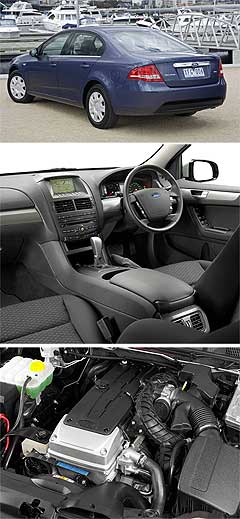First drive: FG Falcon stuns at base XT level
BY MARTON PETTENDY | 10th Apr 2008

Priced from $36,490, the XT four-door is $500 more expensive than the ($35,990) BFII XT it replaces but, more importantly, remains $300 less than its most direct rival in Holden’s Commodore Omega sedan.
Holden recently upped the ante by making side curtain airbags standard on all VE Commodore sedans, including the Omega, in addition to twin front and side airbags. But the most basic large Ford sedan comes standard only with twin front airbags, plus seat-mounted thorax and head-protecting side airbags up front.
Adding head protection for rear occupants of the XT costs an extra $300, making a side curtain airbag-equipped XT the same price as the Omega ($36,790).
Ford claims that, typically, Falcon XTs spend 90 per cent of their time on the road with just one or two front occupants on board, hence its decision to make full-length side curtains optional rather than standard – as they are from Fairmont Ghia-replacing G6E level upwards.
With or without them, Ford insists the FG is the safest Falcon it has ever produced, following the most comprehensive vehicle crash program it has ever conducted.

While the XT goes one better than its opposite number by coming exclusively with a new five-speed Ford automatic sourced from France (the Omega continues with GM's aged four-speed auto), the base Falcon is also available with ZF's carryover six-speed auto ($1500).
Holden's Commodore upgrade, announced on the eve of the new Falcon's launch on March 15, also included the fitment of 16-inch alloy wheels as standard on the Omega. The move sees it go one up on the XT, which comes to market with 16-inch steel wheels hidden behind plastic wheel covers. Alloy wheels are a $500 option on the XT sedan.
Of course, Holden has finally made air-conditioning standard on its Omega, but the Falcon XT scores superior climate-control air-conditioning as standard.
Along with a new grille, body-coloured door handles and side mirrors complete the Commodore Omega update, but the latter are just two of a host of new features for Ford's first all-new Falcon since the unloved AU series emerged a decade ago in 1998.
Other new-to-XT technology, shared across the 92 per cent new FG Falcon range, include a new Virtual Control Pivot Link front suspension, a forward-mounted Y-shaped steering rack with variable-ratio steering gear, monotube shock absorbers, an Australian-first self-adjusting parking brake, a flip-out remote key and one-touch starting.
There is now also automatic instrument cluster illumination, a front passenger Beltminder (in addition to the driver's), rear power windows (in addition to the front), outside temperature display, one-touch indicators (for lane-changing, as on Commodore), digital speed display (like Commodore), auxiliary audio input, multi-function display, set-point cruise control, a larger 5.8-inch LED-backlit LCD display screen and a four-speaker 112-Watt single-CD/MP3 audio system with mid-range sound adjustment (in addition to bass and treble).
Distinguishing the XT from the rest of the FG range is a chromed grille header bar, black-bezeled bright-ring headlights and a chromed rear bootlid appliqué, while inside it offers "Domain" cloth trim with "Metro" cloth inserts.
The newest Falcon XT continues to offer a trip computer, steering wheel audio controls, automatic headlight control, remote central locking, power mirrors, a 60/40-split folding rear seat (unlike Commodore) and four-way power driver's seat adjustment.
Apart from all-new Territory-style alloy front suspension that is claimed to reduce weight by 22kg and a new variable-ratio steering system that requires just 2.6 turns lock-to-lock and returns a class-leading 11.0-metre turning circle, the Falcon XT features all-new exterior sheetmetal and a redesigned interior, with best-in-class front and rear head, shoulder and hip room (but not legroom).
Of course, while Toyota's Aurion delivers a 200kW power output and Honda's new Accord V6 is Australia's most powerful large sedan with 202kW, the Falcon XT's revised DOHC 4.0-litre inline six-cylinder engine betters Commodore with 195kW at 6000rpm (up from 190kW), and some 391Nm of torque at 3250rpm – up from 383Nm, which was already well up on the torque outputs of both the Omega and the Aurion.
Desite this, fuel consumption is down to a Commodore-beating 10.5L/100km – from 11.5L in BAII guise, 10.9L in BF guise and 10.7L in BFII guise.
Ford says the FG Falcon's completely redesigned body structure offers a vastly bigger interior that is easier to enter and exit thanks to wider door openings and wider-opening doors, as well as bringing big advances in NVH (noise, vibration and harshness) and overall refinement.
Combined with a revised version of the previous Falcon’s Control Blade independent rear suspension, plus a one-piece body side, triple-sealed doors and Goodyear Eagle Excellence tyres, it claims the FG Falcon sets new Australian benchmarks for dynamics and ride quality.
Other Falcon XT options include prestige paint ($400), a 1600kg tow pack ($495), a reversing camera ($500), reverse parking sensors ($500), 17-inch alloy wheels ($1000), premium sound ($1100), satellite navigation ($2000), leather seat trim ($2100) and, for the first time, a full-size spare wheel/tyre ($100 – as on Commodore).
Read more:
First drive: New Falcon XR8 now the black sheepFirst drive: Ford raises its game with new G6
Shooting star
Ford to renew push for Falcon exports